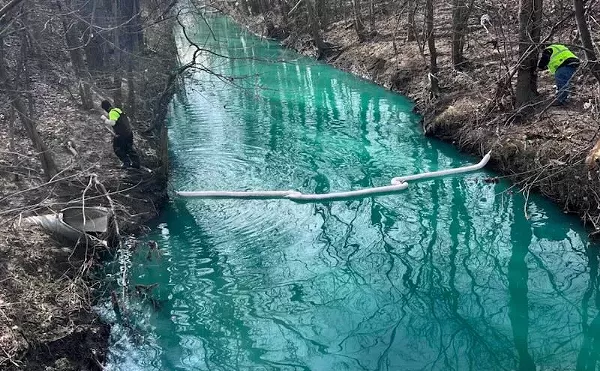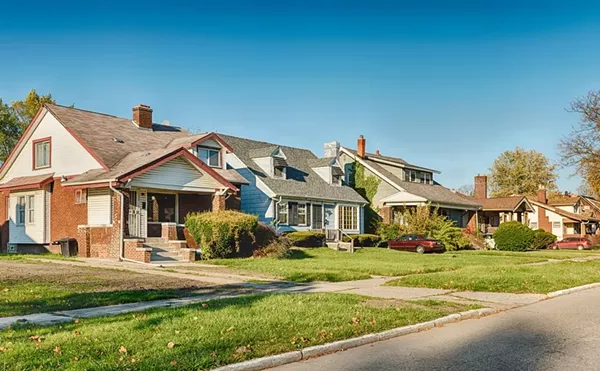How Detroit’s arson investigators and a local prosecutor are extinguishing the flames
The Fire Next Time

Audio By Carbonatix
[
{
"name": "GPT - Leaderboard - Inline - Content",
"component": "35519556",
"insertPoint": "5th",
"startingPoint": "3",
"requiredCountToDisplay": "3",
"maxInsertions": 100,
"adList": [
{
"adPreset": "LeaderboardInline"
}
]
}
]
Hope for better things — what some Detroiters might have felt when they watched any of the four buildings off Grand River near Livernois and Joy Road burn just over a week ago.
But that's not what the chief of arson and fire investigations in Detroit does.
Chief Charles Simms plans for better things, and is working to lay a solid foundation for Detroit to build on.
In his office downtown, a week before Angels' Night, Simms sits at a round table. There are big jars of candy on it, Tootsie Rolls and Twizzlers — "My lunch," he jokes, not looking nearly old enough to have been with the Detroit Fire Department for 28 years. He smiles amicably and gestures for us to sit, turning periodically to answer his desk phone.
Across the table from him, there is a wall that acts as a white board. On it, a list of solved serial arsons, written in red marker, with the number of fires set and the status of each case. Some number 100+.
Because, not surprising to anyone who lives in metro Detroit, the vast majority of fires in Detroit are arson.
But under Chief Simms' watch, that's changing.
The Motor City Muckraker
Detroiters, it may seem, are a bit jaded when it comes to fire, especially arson. Many don't want to talk about it, preferring to ignore the matter as if that will make it go away. But on any given day in the Motor City, there are 10 to 12 "suspicious" or "intentional" fires. Clearly, not talking about it is not extinguishing the problem.
The media tends to not necessarily help either, jumping on stories of impoverished firehouses: People nationwide saw the video of the Faygo pop can on the fax machine used to alert the firefighters. Even Steven Colbert mocked it.
There are some journalists, though, who take covering Detroit's fires and fire department seriously, and work hard to get information about what's going on to the public. One who stands out is Steve Neavling, better known to many as local gadfly Motor City Muckraker.
Neavling is up day and night, often live reporting fires and the perils of Detroit's fire department. When the Fisher Body Plant went up in flames last week and a firefighter was injured, Neavling reported the event, and posted the scanner recording of the incident to his site, motorcitymuckraker.com. "I try to do live reports as much as possible," Neavling tells Metro Times. "So many people wanna talk — and they feel like the city isn't doing enough about it." They're worried, he says, about their homes and communities.
Neavling monitors the fire scanners, recording 24/7 so he can catch fire calls he might miss. "About this time last year, I asked Mayor Bing's office for copies of the fire runs — where the firefighters are going, and they got back to me and were like, 'We don't know. We don't have those records available,'" he explains. "The only way that I was going to figure out where the fires took place was to listen to every fire run, and that's what I did starting on Jan. 1, and just worked my way up to now."
Neavling meets with us on a few occasions to talk about his work for this article. Each time, his pale, curly red hair dances around his face, and his eyes sparkle behind glasses. One thing is clear: Neavling is passionate about his commitment to reporting on fire. "Fires are burning neighborhoods ... [and there is a] disproportionate response to underserved communities, lower-income families than areas like Midtown and downtown." His voice is soft when he speaks, yet carries the potency of conviction.
"Most houses that burn down, they just sit there like they're ready to collapse, and they're ugly. Those houses don't get torn down at the same rate that the houses closer to Midtown and downtown do. There was a big church on Woodward that burned down, and immediately the Duggan administration had the rest of that church demolished. There was a woman who was on the east side and her neighbor's house had burned, and it was leaning on her house. The fire department told the city, 'If you don't get rid of this house that's leaning against her house, her house is going to burn down.' They didn't remove the house! It's disproportionate and the city's using the fires to their advantage, because there are neighborhoods that the city is writing off.
"It just seems like because it's happening disproportionately in poor neighborhoods, no one's paying attention to it," says Neavling. "All the big media is caught up on the pop can situation," or what's going on downtown and in Midtown, "but they're not seeing what's really happening in these neighborhoods that are being devoured every day."
Worse, says Neavling, echoing what many in Detroit might believe, arsonists "rarely get caught because of it."
Catastrophic Revenge
While it is true Midtown and downtown receive the lion's share of the media's attention, the numbers on the wall in Chief Simms' office tell a different story on who is caught and prosecuted. Behind them, Wayne County's assistant prosecuting attorney in charge of the arson unit, Louisa Papalas, is spearheading justice.
Papalas began her career 20 years ago. A graduate of the University of Detroit (just before it became U-D Mercy), prosecuting, she says, was "a higher calling" to public service. She got her start in homicide, and moved on to the child-abuse unit. When grant funding became available in early 2011 through the Michigan Arson Prevention Committee in conjunction with the National Insurance Crime Bureau to prosecute and investigate arsons, she volunteered. "These are to me the most challenging cases," she tells Metro Times. "They involve circumstantial evidence, building a case on motive, opportunity, [and] what was the means. You have to make juries care about these cases. When you have a burned-out house, it's difficult for people to see the victim — how is anyone victimized if no one was hurt? The insurance company?" You can hear in Papalas' voice that an insurance company is clearly not a sympathetic victim to a metro Detroit jury.
But Papalas knows who is. It's not just the fire department that's a victim, or even an entire neighborhood that's a victim of arson, she explains. "We're all victims of this. Just because someone's not injured, our sense of safety in our community" is affected. And also, she points out, the insurance premiums that are paid.
The Wayne County prosecutor's media liaison provided Metro Times with a 17-page document that lists every arson prosecution since 2011, the beginning of the grant, through last week.
Line item after line item tells the story of arson in Detroit: Anger, revenge, or profit make up about 75 percent of the cases. Anger at landlords or family members, revenge on exes or landlords, and profit via insurance fraud are most prevalent.
The other 25 percent? Mental stability and competency issues.
There's also the serial arsonist — a firebug whose motive can include revenge or anger or mental health problems.
And, in addition, the serial arsonist-scrapper, who sets fires to make it easier for scrapping.
Sometimes, explains Neavling, there is arson as a solution to a community's drug problem: "There's a drug house, and that's one way for the neighbors to get rid of a drug house — burn it down. Firefighters have come under attack for that very reason, because people wanted to see the house burn. Firefighters are extinguishing the fire, and they want the house to burn down."
Nearly all these cases from Wayne County — 87 since 2011, plus two serial arsonists recently arrested for the fires off Grand River — with the exception of those that are pending or found mentally incompetent, have resulted in convictions. With convictions comes restitution, and many receive prison time. Some get sentenced to 50 or more years. (Papalas successfully petitioned the state legislature in 2013 to increase penalties for those who commit arson that results in injury.)
Others are diverted to mental health treatment. Mental health cases, says Papalas, are challenging, because "you know they'll do it again. They don't know how to control their behavior. And they are creating situations where the fire spreads down the block to occupied dwellings, and then you have people homeless and potentially injured over someone who has a thrill. We don't have the capacity to treat that at a local facility here, and unless they're found to be incompetent, if they're found or plead guilty, I ask for prison time. Otherwise, there's not a lot of other options."
Papalas describes the bulk of her work as "handling fraud" and "catastrophic revenge." Often, when it comes to revenge, a defendant will feel like they "got burned" by someone, metaphorically, so in retaliation, they decide to physically burn their offender. She describes text messages defendants have sent, such as threats like "You're gonna burn" and "I've got something hot for you."
She notes that arsons related to auto theft and domestic violence are often handled by prosecutors in the domestic violence and auto units.
"I'm the only prosecutor assigned to the arson unit," she says. "I have the assistance of an investigator interviewing and subpoenaing witnesses. We had a second [prosecutor], but since we lost the grant, we no longer have that."
"We try to charge as many as we can," Papalas continues. "People should not be afraid to come forward and not be afraid to share what they've observed. It's such a refreshing experience when we do get a neighbor that's ready to stand up for their community and their block and say 'This isn't to be tolerated. I don't wanna live in a burned-out neighborhood.' They'll come to court and describe what their neighbor did. I respect the courage that these people have to come forward to reveal what they saw." Papalas says that even if "they'll describe it on a 9-1-1 call, we're able to bring those people to court."
Steve Neavling agrees with Papalas. "I've talked to people who say they can't sleep at night because they're afraid that the abandoned house next door is going to be burned down," he says. "I don't know if there's a lot they can really do except report suspicious behavior."
And when there is a suspicious fire, it's Detroit's arson investigators who step up.
The fire department's arson investigators, says Papalas, are the most hard-working people. "They put their lives at risk, and that's something that I'm immediately impressed with and in awe of. I'm proud to work with them, and I learn every day from them."





